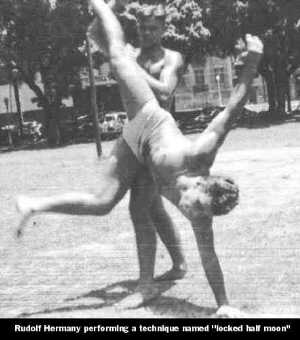
By Antonio Rodrigues and Joseph R. Svinth
Copyright EJMAS © 2000. All rights reserved.
Capoeira is Brazilian. That much is certain. Beyond that, it is many things at once, being simultaneously a dance, a kind of game, a Brazilian cultural and musical art, and a martial art.
Until the 1930s, books usually referred to capoeira as Jogo de Capoeiras ("Game of the Capoeiras") or Capoeiragem, and "capoeira" referred to the player of the game rather than the game itself. (And "players" is the correct term; while outsiders often call people who practice capoeira "fighters," the participants consider it a game rather than a fight.)

Capoeira, at least as played today, developed among working-class black people in Brazil, and its history, which was rarely written before the nineteenth century, is based on oral tradition rather than old documents or paintings. Thus there is a lot of myth and folklore, but not much that is certain.
For example, there is a story that Zumbi, who was the leader of Quilombo dos Palmares, created capoeira during the seventeenth century. Quilombos were strongholds built by fugitive slaves (quilombolas) and the biggest and most famous of these strongholds was the Quilombo dos Palmares, which was destroyed around the end of seventeenth century. Zumbi seems to have been a historic person, but nobody knows if he really knew capoeira, and there are documents suggesting that capoeira was practiced before Quilombo dos Palmares was built.
There is another story that capoeira came from Angola. Now, while capoeira has a distinctly African flavor, researchers who have gone to the various parts of Africa where the slaves were captured have not found anything like it. Perhaps the African arts died out under colonialism, but still one does not find in capoeira the orishas and other manifestations of African religion that one finds in Candomblé, Santeria, or Vodoun. So this suggests that capoeira is Brazilian rather than African.
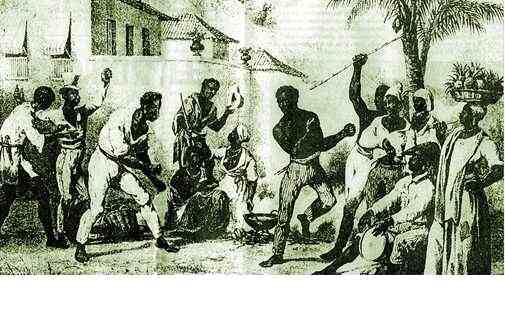
A picture by the famous French artist Jean-Baptiste Debret depicting
capoeira; the artist lived in Rio from 1816-1831.
Certainly the word "capoeira" is not of African origin. There are varying explanations of what it means, but the most convincing is that it is the Tupi-Guarani Indian word for "tall grass."
According to one version of the story, runaway slaves and Capitàes do Mato (literally, Captains of the Bush, but meaning slave-catchers) ambushed one another in the tall grass, and thus capoeira came to mean the kind of fighting done by desperate men outside of town. This sounds good but isn't very sensible if you think about it. After all, slave-catchers were armed, so individual runaways would have avoided them whenever possible. On the other hand, when banded together in quilombos, then the runaway slaves would have fought with spears, machetes, and firearms, just like anybody else.
According to another version of the story, people travelling in the country cut paths through the tall grass. Criminals and highwaymen awaited the unwary, so townspeople started saying, "Beware the capoeiras," meaning "Beware the bandits who lurk in the tall grass." But keep in mind that back then, Brazilian society was based on slavery, and that white people typically considered any strange black, Indian, or mulatto to be a potential bandit. So whenever a group of these people got together to talk or play, the white people said, "They were playing capoeira," but meaning any suspicious get-together.
There is a theory at the Bahia Federal University that capoeira had its origin on the Bahian docks. According to this theory, which the authors heard from Renato Alcantara, sailors and stevedores played physical games such as capoeiragem and batuque (bah-too-keh), that required the players to move their opponents outside a circle without the use of hands. Capoeiragem was therefore simply a physical game.
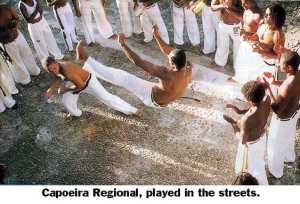
Anyway, some more legends. Around 1815 the Crown Prince of Brazil (and later its first Emperor, and later still King of Portugal), Pedro Orleans and Bragança supposedly learned capoeira from his palace slaves. But this is unlikely, as back then a Brazilian prince with imperial ambitions would have been more likely to learn Spanish fencing than capoeira. It has also been said that some early nineteenth century police officers were also capoeira players. But capoeira was illegal in Brazil from 1810, and it's not likely that policemen would risk their jobs to play a game that didn't pay money.
Sometimes you hear about a battalion of capoeira players during a Brazilian war with Paraguay. What happened is that in 1864 Brazil, Argentina, and Uruguay formed a Triple Alliance against Paraguay, and one Brazilian battalion, the Zuavos, was formed of runaway slaves who after being caught were offered the choice of being shot or joining the army. Of course the men from the capoeira volunteered for the army, and as a result they became known as the Voluntários da Pátria, or "Volunteers of the Nation".
Until the 1830s, capoeira was apparently practiced without music. Because of laws against capoeira, there is a theory that the music was introduced as a way of disguising the practice as a dance. But if Alcantara's theory that sailors and longshoremen created capoeira for recreation is correct, then probably the sailors and longshoremen added music simply to make their games more fun. Either way, the introduction of music changed technical aspects of the game, and rhythm started to become more important to the players. Ultimately this led to capoeira having a ludic aspect that it apparently lacked before, and to capoeiragem being played in the streets before audiences.
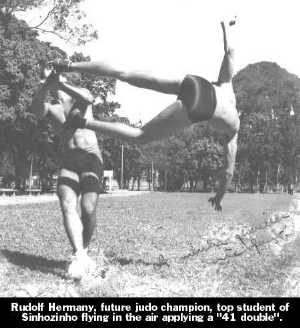
Meanwhile, in Rio de Janeiro, maltas, or street gangs, recruited thugs that the newspapers called "capoeiras" and used them to extort money from people. Politicians employed these same thugs to persuade people to vote for them, and eventually election reforms led to new bans on capoeira. This is why another old name for capoeira is "Vadiação," a word meaning something like "vagabondery".
With so many thugs playing the game, Rio capoeira was rough stuff, and its teachers eliminated all the pretty moves that were not much use in real fights. For example, kicks were lower, and aimed at the body rather than the head. The hands were used in various ways to deceive or to deliver punches to the body or finger strikes to the eyes. There was no music, no cartwheels, and no acrobatics except those that were combat-oriented.
Capoeira Carioca (Carioca means "born in Rio") also included training in weapons. These weapons were not firearms, because those were expensive, but straight razors, canes, and wooden sticks. The razors were known as Santo Christo, or Holy Christ, probably after the crossing patterns, while the sticks were known as "petropolis." That means "Peter's City," which is the name of a community in Rio, so perhaps that is where the technique developed.
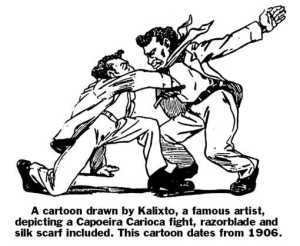
Rio gangsters also wore red silk scarves around their necks. This was mostly to look dashing and show their gang affiliations, but they said that it was to protect their necks from razor cuts. (Usually a razor blade does not cut silk, instead it gets stuck.)
Strangely, capoeira Carioca was the first capoeira to be documented in a military manual! This one was written in 1907 by a naval officer who preferred to stay anonymous, and was entitled "The Guide of Capoeira -- Brazilian Gymnastics." The idea was probably to introduce a national form of fighting into recruit training, as the British had done with boxing, the French with savate, and the Japanese with judo.
In 1916, Captain Ataliba Nogueira and Lieutenants Lapa and Leite, all of them members of the Military Police, published another "Manual of Capoeira." Intended for military personnel only -- capoeira was still banned by law -- this was one of the best books on capoeira ever written. These authors would have been white, as back then blacks were hardly ever promoted higher than the rank of sergeant.
Of course soldiers and sailors were not the only ones doing capoeira in Brazil, just the only ones publishing books about it in the nation's capital. Capoeira Angola (though not yet known by that name) was the method most practiced in the northeastern states of Bahia and Pernambuco. As most practitioners were working men of African descent, it continued to have an unsavory reputation with white people, and therefore it remained illegal.
Then capoeira Regional came to be.
In this case one man made the difference. He was named Manuel dos Reis Machado, but was better known as Mestre Bimba. (It is a capoeira tradition that people take nicknames upon promotion to mestre. It isn't required, but almost everybody does it.)
Mestre Bimba (pronounced been-bah) was born in the Bahian capital of Salvador in 1900, and started learning capoeira from a merchant marine captain named Bentinho around 1912. By the time he was 19, he was a master, and since he preferred the martial aspect to the ludic (although he did both very well), he became feared as a terrific fighter, winning challenge matches against boxers, jujutsu men, etc. He never fought for money, just for the pleasure, but probably others made money betting on him, or lost it betting against him.
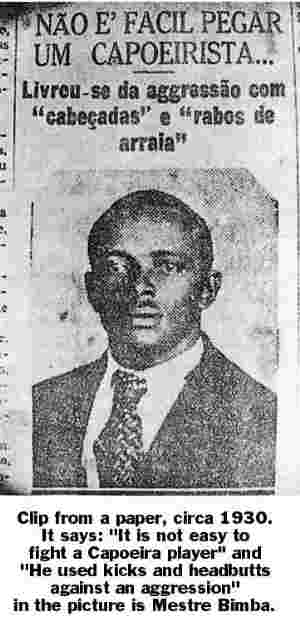
Mestre Bimba earned his living working as a stevedore. Although he did not know how to read or write, he was a personable and intelligent man, and because he was a famous fighter, soon wealthy young men began approaching him asking for instruction. At first he taught students in their homes, but by 1932 he had so many students that he decided to open an academy. This was the first non-military capoeira school in Brazil, and it is today in the same place.
With all these white, middle-class, and Catholic young men training in an art that had previously been done mostly by black, working-class, and Candomblé-practicing young men, Bimba knew that capoeira had to change. You see, the traditional Bahian capoeira, the kind today called Angola, was not taught in schools. Instead, a prospective student approached the group, and if he was accepted he watched and tried to imitate the others. Bimba's well-educated white students were used to different methods, so to please them Bimba started teaching his classes in the same way the Catholic schools did, namely by taking beginners aside and teaching them increasingly difficult techniques in a systematic method. Furthermore, because his patrons were mostly white, he also stressed capoeira's Brazilian rather than African roots.
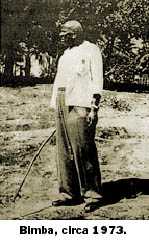
It is true that Bimba preferred some movements to others, particularly the ones most suited to combat, but contrary to the purely violent version practiced in Rio he kept a lot of elements of the traditional capoeira, such as music. Indeed, he was a talented player of the traditional instruments berimbau (pronounced beh-rin-bow), caxixi (pronounced kah-she-she) and atabaque (pronounced ah-tah-bah-keh), and he added some prayers and rituals from Candomblé religion.
Bimba is said to have incorporated some techniques from boxing and judo, but probably there isn't much truth to this. After all, the hands are used for striking in Angola, too, and while Regional has some hip throws and arm locks you don't need to know judo to know how to do those. But it is possible, as you don't see these techniques in Carioca or Angola, only Regional.
Anyway, Bimba wanted to teach students a mixture of practical fighting and traditional culture. So he taught them to play musical instruments and to set traps and ambushes and use dirty tricks, and he talked about capoeira's Brazilian rather than African heritage. Nevertheless the pedagogical method was Bimba's true innovation, and this was most responsible for making a formerly working-class art palatable to rich white people.
Of course capoeira was still illegal. So to open his school Bimba couldn't say he was teaching capoeira. But, as boxing, wrestling, and judo were not illegal, one of Bimba's students, a lawyer, suggested that Bimba should simply use a different name. The name chosen was Luta Regional Bahiana, which could be translated as "Bahia's way of fighting." But everybody knew what it was and so everybody called it capoeira Regional ("from that region" "local").
Shortly after, Bimba's students, some of whom were the sons of big-shot politicians, started to work for capoeira to be legalized, and they were lucky. During the 1930s Brazil was under the dictatorship of Getulio Vargas. Vargas was a fascist, but he was also a nationalist, and in capoeira he saw a national art that should be promoted rather than banned. Therefore new laws were written that allowed capoeira to be taught in licensed academies and demonstrated publicly provided permits were obtained.
With the new laws, traditional teachers also began renting rooms and obtaining business licenses, and soon there were capoeira schools everywhere. To distinguish between traditional capoeira and capoeira Regional, during the 1950s people started calling the traditional method "Angola." No one knows who first started this name, or precisely what it meant. A good bet is that the name referred to the slaves who started capoeira and who came from Angola and the Kongo kingdoms, in Africa. But that is a guess.
While Regional grew like crazy during the 1950s, Carioca did not. The reason was that as Bimba's students moved south to Rio, they brought a new, less violent and more acceptable, respectable, and beautiful form of capoeira to the capital. Carioca on the other hand continued to be associated with gangsters and the Brazilian military and police. (Military and bandits, a strange combination, isn't it. Or maybe not so strange, if you think about it long enough.) So during the 1940s and 1950s there was only one Carioca school in all Brazil that was open to the public. This school was at Ipanema Beach in Rio, and headed by Mestre Sinhozinho (Agenor Moreira Ferreira).
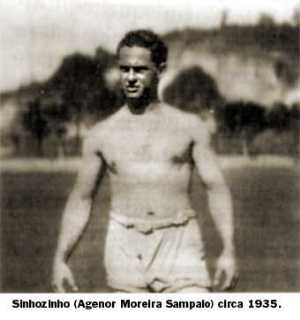
Sinhozinho (pronounced Seen-yo-zeen-yo) was born in Santos (the largest port in Brazil) in 1891. The son of an army officer, he learned his capoeira on the docks of both Santos and Rio. He also wrestled Greco-Roman and arm-wrestled.
Like Bimba, Sinhozinho knew how to make money teaching capoeira. The capoeira he taught had no music and emphasized combat-effectiveness rather than tradition. And, like Bimba, he catered to middle-class students. Some became famous, too, to include Pan-American judo champion Rudolf Hermany and musician Tom Jobim.
However, unlike Bimba, who systematized his classes, Sinhozinho taught all his students in an individual way, each differently from the other. In the end, everyone knew the same techniques, they just got there by different routes. Did it work?
Well, once Bimba brought two of his best students to fight Sinhozinho’s students and after a couple of minutes both Bimba's students needed to go to a hospital. Bimba did not fight, but it is said that he absorbed some movements he saw in the fight and when he got back to Bahia he incorporated them into Regional.
Nevertheless, Carioca under Sinhozinho was not a system, just a school. So when Sinhozinho died in the early 1960s his method died with him. The more standardized Regional, however, flourished. So in this regard it is fair to consider Bimba the Jigoro Kano of capoeira.
And what became of Angola?
It survived, thanks mostly to the efforts of Bahia’s most famous master, Mestre Pastinha. Pastinha was born on April 4, 1889. His father was a Spaniard while his mother was a black Brazilian, and his full name was Vicente Joaquim Ferreira. As a boy, Pastinha (pronounced Paz-teen-ya) learned capoeira from a black man called Mestre Benidido, and by the time he was twelve he was such a good fighter that he was able to obtain employment as a bouncer in a brothel. (Nice job for a twelve-year old, eh?) He got enough fighting in his day job so when he opened a capoeira school in 1941, he taught it in the old way, by observation, without a formal method, and in this way he kept the traditions alive.
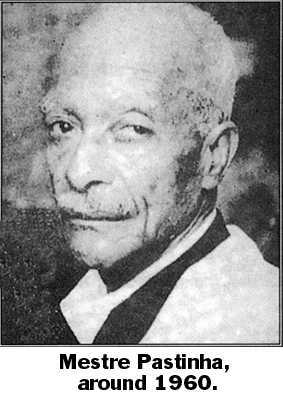
Pastinha and his students were soon giving demonstrations to groups of tourists in the hotels of Salvador, Bahia’s capital city, and recording capoeira’s music. This made them lots of friends among intellectuals who saw Pastinha as a treasure of black culture and this helped him stay with his pursuit.
Bimba liked Pastinha, and respected what he was trying to do. Personally he thought many of the old moves were technically useless, so he did not allow beginners to do them, but he encouraged advanced students to learn them. So today it is common (not the rule, but common) for capoeira players to practice both "families," as Regional and Angola are termed in Portuguese.
Bimba died on February 5, 1974, with many students, many friends, and little money. Pastinha met the same fate in a public asylum on November 13, 1981. About the same time, capoeira began going abroad, especially to the United States. Two of the pioneers were Bira Almeida in California and Jelon Vieira in New York. Some people have said that Vieira's methods influenced the break-dancing craze of the 1980s, but that was really owed to the New York City dance troupe called High Times Crew.

So having gone through some history, what is the difference between Angola and Regional? Technically, not much. Both use music and teach traditions, and both are ludic as well as combative in nature. There is, however, a difference in spirit and approach. In Regional, the Brazilian roots are stressed and the game is usually played from an erect stance. And, while the speed of the acrobatic movements varies from player to player, Regional is generally fast. On the other hand, in Angola the so-called "African roots" are stressed and the game is generally played very slowly from low stances. The reason, say the Angolans, is that this allows them to do a better job of hiding their true intentions, plus serves to lure the unwary into traps.
Capoeira uniforms are not standardized and the reason is a touchy one. Originally there was no such a thing as a uniform. Instead you just played in your everyday clothes. Some say that Regional's trend toward white uniforms came from the fact that people played capoeira after attending Mass, right in front of the church, and that the white shirts and pants commemorate the white suits that used to be fashionable in tropical Bahia. And some say that you can tell if a player was good by the state of his suit afterwards -- if he goes close to the ground and does not touch, then his suit stays clean and he must be a good player. Well, this may be true or not, but the fact is that Regional students started to wear white pants and t-shirts only recently. And, to distinguish themselves from Regional players, the Angola players have taken to wearing blue pants with yellow shirts. Why these colors? Easy -- they were the colors of Ipiranga Football (soccer) Club, Pastinha’s favorite team.
Both Regional and Angola are also practiced without shirts. Currently only men play it this way, but nothing says women can't, too!

During the early 1970s the government of Brazil was controlled by the military, and during that time the government tried to transform capoeira into a competitive sport. (Militaries like sports better than art because you can put a lot of regulations into sport that you can’t put into an art.) Federations were soon created, and the politicians in charge of them decided that capoeira had to become a sport like boxing instead of staying that typically Brazilian mixture of dance, fighting, and trickiness. Well, that did not work, but even today there are still some who dream of getting capoeira into the Olympics.
Belt rankings were introduced during this time, too. Although the belts were made from rope, otherwise this ranking system was similar to (and borrowed from) the similar systems used in judo and other Japanese martial arts. The basic structure is:
Lately some teachers have adopted additional colors for use by children. Usually these are red, orange, and purple. But nowhere is there standardization, and so each organization has its own system of grading and belt colors.
Some capoeira schools also teach maculelê (mah-koo-lay-lay), which is a kind of dance that features whirling machetes and flaming torches. Although some people say that maculelê was originally a fighting method developed by Pernambuco sugar cane workers, this is probably just another story; instead, it seems likely that maculelê was actually developed during the 1940s for the purpose of entertaining tourists.
During the twentieth century there were sometimes fights between capoeira players and judo men and Western boxers. For example, in a book about capoeira, there is a tale of a fight that supposedly took place in 1913 between a capoeira player named Ciriaco and a Japanese jujutsu champion named Sada Myako. According to the story, the Japanese was knocked out with a violent spinning kick, a technique called "meia-lua de compasso". Well, nobody ever heard of a capoeira player named Ciriaco, and while there was a Japanese wrestler named Taro Miyake and another named Sada Kazu Uyenishi, neither was in Brazil at the time. Furthermore, when Japanese wrestlers and judo men did come to Brazil, they seem to have won most of their matches. [EN1] So this story could be a fantasy.
In Bahia, before Bimba, there is no written record of this kind of fight, but doubtless they happened. After all, there were boxers and wrestlers on board visiting merchant ships and capoeira players among the Brazilian longshoremen, and Bimba said he fought many times and never lost to anybody. But let's be fair here -- he never met Maeda or the Gracies, either. The Gracies fought a lot of capoeira players during the 1950s and 1960s and always won, but the only Brazilian (let's keep Masahiko Kimura out of this) to ever beat Helio Gracie was Waldemar Santana, who had studied under both Helio Gracie and Mestre Bimba’s student Arthur Emidio in Rio. And some years ago in an "Ultimate Fighting" event, a capoeira player called Mestre Hulk knocked out a Gracie Jiu Jitsu champion named Amauri Biteti. Biteti was the favorite and was beating everybody that night and then during the final match he made a big mistake. Instead of going to the ground where he was supreme, he chose to fight Mestre Hulk in a boxing style and was knocked out cold.

The most famous capoeira players of the old days are surrounded by legends. Examples include Zumbi, who was described above, and Manduca da Praia. Manduca was from Rio, and nobody ever knew his real name. He was a hired gun for dirty politicians, and his most famous battle was with a visiting Portuguese congressman named Santa Ana. Congressmen were sprightly in those days, too, as according to the story Santa Ana was a famous street fighter in Europe, and the contest ended with both men exhausted and drinking champagne in a brothel. The last part may be true. There was also a Major Vidigal who was supposed to have been a policeman in Rio during the early 1800s, but outside of novels no one seems to know much about him.
In the twentieth century there were some famous players who were not legendary. One was Manuel Henrique of Bahia, whose capoeira name was Besouro Mangangá. ("Besouro" means "beetle" while Mangangá means "Devil's horse," and refers to an aggressive Brazilian wasp.) Mangangá believed himself a Filho de Santo, Son of a Saint. In Candomblé, a Son of a Saint is someone who has taken on an African spirit and is therefore impervious to wounds. As a result he believed that no bullet could catch him, no blade could cut him, and he was one hell of a capoeira player, too.
Mangangá came to a sad end, however. It seems he worked as a mercenary for some corrupt politician, and one day some people he didn't know were his enemies offered to buy him a lot of drinks, and when he finally got really drunk, they stabbed him. He did not die on the spot, though. Instead it took him a whole day to die, and the guys who stabbed him made sure nobody helped him.
Then there was 22 from Marajó. The number refers to the man's number in the navy and the latter is where he came from, an island in the extreme north of Brazil. In his time he was said to be invincible, and he was immortalized in a short story written by one of Brazil’s most famous writers, Monteiro Lobato.
Some of the best recent Regional players were Arthur Emidio, Suassuna, and Atenilo. Their peers among the Angolans included Bola 7 and Canjiquinha.
And, finally, let's not forget the last of the capoeira bandits, Rio's Madame Satan. Satan was colorful, to say the least -- he was a transvestite, the owner of a Rio brothel, the leader of a gang of thieves, and reportedly the killer of more than ten people. But he was also a modest man, and in a published interview Satan denied killing anybody, he just made some holes in people and God killed them. In his prime, even the police were afraid of Satan but in the end he was betrayed by his lover and spent the rest of his life in jail, where he died during the early 1970s. His real name was Aristoteles de Jesus.
Capoeira faces new challenges in the twenty-first century. Doubtless capoeira will flourish in the new globalized society, which is good, but it would be sad if it lost its Brazilian character. To be capoeira, it must remain more or less the same thing in France, the United States, or Japan as it is in Brazil. This is not a matter of martial aspects from other cultures being incorporated in the art, as this has always happened. For example, if kids watch kung fu movies and then incorporate those kicks into capoeira, it will still be capoeira. The problem is not rhythm or music, either. After all, it doesn't matter if you sing the song in Portuguese or English or German. The difficult part will be maintaining the Afro-Brazilian ritual. In Brazil, even if you are Roman Catholic or Jewish, you still feel the African and Candomblé roots, but in Australia or Canada you might not. To be Brazilian is to be very mixed.
How this will work out, only time will tell.
For Further Reading
Portuguese
Books
-----. Capoeira, o galo já cantou (Rio de Janeiro: Editora Record, 1997)
-----. Pequeno Manual do Jogador de Capoeira (Rio de Janeiro: Editora Record, 1999)
Mestre Bola 7 (José Luiz Oliveira). Capoeira Angola na Bahia (São Paulo: Editora Ground, 1999)
Pereira da Costa, Lamartine. Capoeira sem mestre (Rio de Janeiro: Edições de Ouro, 1963)
Valdeloir do Rego. Capoeira Angola (Salvador: Editora Itapuã, 1968)
Zuma (Anibal Burlamaqui). Ginastica Nacional e Capoeiragem Metodizada e Regrada (Rio de Janeiro: Self-published, 1928)
Ministério da Educação e Cultura. "Revista Brasileira de Folclore" (Rio de Janeiro: Ministério da Educação e Cultura, 3:5, 1963)
Capoeira, numbers 3, 5, 6, 7 and 11 (1998-1999)
Kiai, number 22 (1994)
Do, numbers 1, 3, 4 and 5 (1978)
English
Books
-----. Capoeira: A Brazilian Art Form (Berkeley, CA: North Atlantic Books, 2nd edition, 1986)
DeMarinis, Valerie. "Movement as Mediator of Meaning: An Investigation of the Psychosocial and Spiritual Function of Dance in Religious Ritual," in Dance as Religious Studies, ed. by Doug Adams and Diane Apostolos-Cappadona (New York: Crossroad, 1993)
Gilbey, John F. Secret Fighting Arts of the World (Rutland, VT: Charles E. Tuttle, 1963)
-----. The Way of a Warrior (Richmond, CA: North Atlantic Books, 1992)
Holloway, Thomas H. Policing Rio de Janeiro: Repression and Resistance in a 19th-Century City (Stanford, CA: Stanford University Press, 1993)
Lewis, J. Lowell. Ring of Liberation: Deceptive Discourse in Brazilian Capoeira (Chicago: University of Chicago Press, 1992)
Marre, Jeremy and Hannah Charlton. Beats of the Heart: Popular Music of the World (London: Pluto Press, 1985)
Thornton, John. Africa and Africans in the Making of the Atlantic World, 1400-1680 (New York: Cambridge University Press, 1992)
-----. The Kingdom of Kongo: Civil War and Transition 1641-1718
(Madison, WI: University of Wisconsin Press, 1983)
"Capoeira," New Yorker, May 15, 1989
Internet
Although most English-language Internet sites dedicated to capoeira are nothing but commercials, there are several useful Portuguese-language sites. If you don't read Portuguese, visit http://babelfish.altavista.com/translate.dyn for translation assistance. Recommended sites include:
EN1. An example, from the Seattle, Washington Japanese-American
Courier, October 4, 1928: "One report from Sao Paulo declares that
Jiu Jitsu is truly an art and that in an interesting exhibition in the
side tent to the big circus a Bahian negro of monstrous dimensions met
his waterloo at the hands of a diminutive Japanese wrestler. The negro
was an expert at Capoeira, an old South American style of fighting, but
after putting the Japanese on his back and trying to kick his head… the
little oriental by the use of a Jiu Jitsu hold threw the Bahian and after
a short struggle he was found sitting on the silent frame of the massive
opponent."
About the Authors
Brazilian Antonio Rodrigues is a former capoeira player, judoka, and karateka who is now an aikido instructor. He has lots of friends, and he likes reading and writing about the martial arts as much as he enjoys training in them.
Joseph R. Svinth is editor of Journal of Combative Sports.